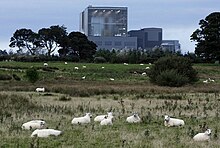Hunterston B nuclear power station
| Hunterston B nuclear power station | |
|---|---|

The Hunterston B AGR reactor building.
|
|
| Official name | Hunterston B |
| Country | Scotland |
| Location | North Ayrshire |
| Coordinates | 55°43′20″N 4°53′24″W / 55.72209°N 4.89009°WCoordinates: 55°43′20″N 4°53′24″W / 55.72209°N 4.89009°W |
| Construction began | 1968 |
| Commission date | 1976 |
| Owner(s) | EDF Energy |
| Operator(s) | EDF Energy |
| Nuclear power station | |
| Reactor type | AGR |
| Reactor supplier | TNPG |
| Thermal power station | |
| Primary fuel | Nuclear |
| Power generation | |
| Units operational | 2 x 610 MWe (Operating at ~495 MWe ) |
| Nameplate capacity | 1220 MWe |
| grid reference NS183514 | |
Hunterston B Power Station is a nuclear power station in North Ayrshire, Scotland. It is located about 6 miles (9 km) south of Largs and about 2.5 miles (4 km) north-west of West Kilbride, on the Firth of Clyde coast.
It has generated electricity since 1976. It is currently operated by EDF Energy. It currently generates up to 1000 MW and is due to operate until 2023.
Hunterston B is very similar in design to the Hinkley Point B power station which is also due to operate until 2023.
The construction of Hunterston B was undertaken by a consortium known as The Nuclear Power Group (TNPG). The two advanced gas-cooled reactors (AGR) were supplied by TNPG and the turbines by C. A. Parsons & Co. Hunterston B started generating electricity on 6 February 1976.
On 3 December 1977 The Times reported that seawater had entered the reactor through a modification of the secondary cooling system. The secondary cooling system uses fresh water to cool various items including the bearings of the gas circulators, which circulate the carbon dioxide (CO2) coolant through the reactor to the boilers. A small leak of CO2 through a seal had developed, and a bypass pipe was installed to remove the water contaminated with CO2 to the seawater cooling ponds. When maintenance work was carried out on the reactor and the pressure in the gas cooling system was reduced, sea water was able to flow back up this bypass pipe and into the reactor. The residual heat of the reactor was such that the seawater evaporated rapidly, leaving deposits of salt in the reactor around the gas circuit. It was estimated at the time that the reactor could be out of operation for a year, that the repairs could cost £14 million, and that electricity tariffs would have to rise by between 1 and 2 per cent. Extensive modelling work was performed in the Nuclear Power Company's (NPC) Whetstone, Leicestershire, fluid flow laboratories to determine where the salt would have been deposited, and the salt was successfully removed by technicians using vacuum cleaners and the plant returned to operation.
...
Wikipedia
